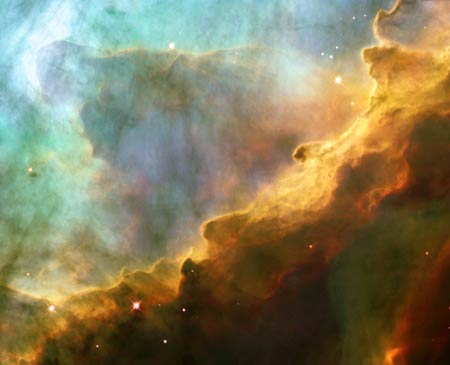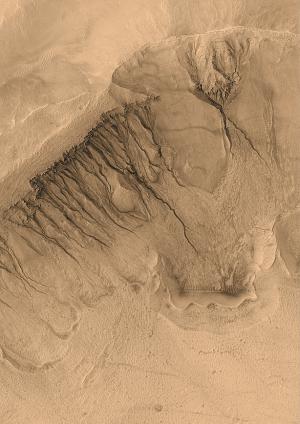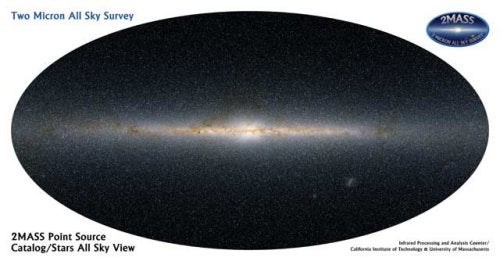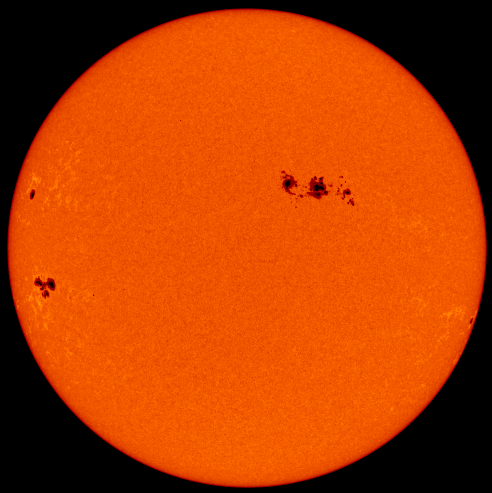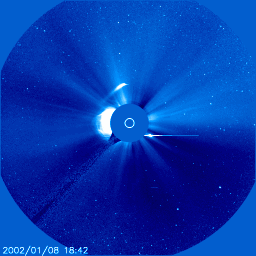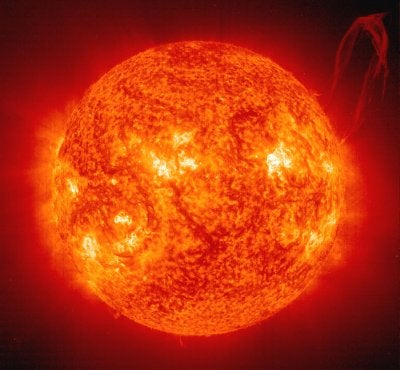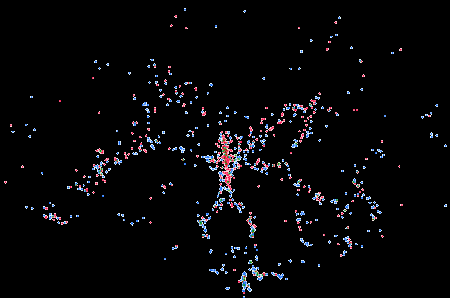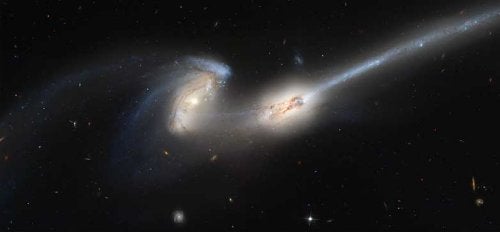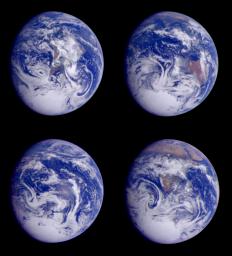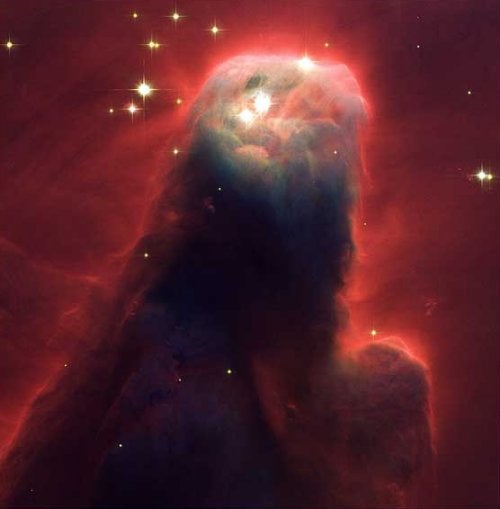Located about 5,500 light-years away in Sagittarius, M17 is also known as the Swan Nebula and the Omega Nebula. The orange-colored, wave-like patterns of gas have been sculpted and illuminated by a torrent of ultraviolet radiation from young, massive stars, which lie outside the picture to the upper left. Material stripped from these clouds form the thin, green-colored veil of hot gas to the upper left.
NASA / ESA / J. Hester (ASU)
M17
Located about 5,500 light-years away in Sagittarius, M17 is also known as the Swan Nebula and the Omega Nebula. The orange-colored, wave-like patterns of gas have been sculpted and illuminated by a torrent of ultraviolet radiation from young, massive stars, which lie outside the picture to the upper left. Material stripped from these clouds form the thin, green-colored veil of hot gas to the upper left.
NASA / ESA / J. Hester (ASU)
Located about 5,500 light-years away in Sagittarius, M17 is also known as the Swan Nebula and the Omega Nebula. The orange-colored, wave-like patterns of gas have been sculpted and illuminated by a torrent of ultraviolet radiation from young, massive stars, which lie outside the picture to the upper left. Material stripped from these clouds form the thin, green-colored veil of hot gas to the upper left.
NASA / ESA / J. Hester (ASU)
This crater is located within Newton Basin in Sirenum Terra on Mars. The gullies which line the walls originate at a specific layer and may have been formed by the release of groundwater. The resolution of the picture is 1.5 meters (5 feet) per pixel, which allows objects the size of school buses to be resolved.
NASA / JPL / Malin Space Science Systems
Martian crater
Water may have flowed very recently on Mars, as evidenced by images taken from the Mars Global Surveyor spacecraft. Images such as this one seem to show water-carved gullies along rocky outcrops inside crater walls. This crater is located within Newton Basin in Sirenum Terra on Mars. The resolution of the picture is 1.5 meters (5 feet) per pixel, which allows objects the size of school buses to be resolved. NASA / JPL / Malin Space Science Systems
Water may have flowed very recently on Mars, as evidenced by images taken from the Mars Global Surveyor spacecraft. Images such as this one seem to show water-carved gullies along rocky outcrops inside crater walls. This crater is located within Newton Basin in Sirenum Terra on Mars. The resolution of the picture is 1.5 meters (5 feet) per pixel, which allows objects the size of school buses to be resolved. NASA / JPL / Malin Space Science Systems
Entire sky imaged by 2MASS
The Two Micron All Sky Survey (2MASS) compiled this infrared view of the sky, in which blue represents close and bright stars in the Milky Way. It also reveals the distribution of galaxies beyond the Milky Way, presenting galaxy clusters and superclusters as filaments throughout the image. More than half the galaxies that appear in this image have never before been cataloged. 2MASS
The Two Micron All Sky Survey (2MASS) compiled this infrared view of the sky, in which blue represents close and bright stars in the Milky Way. It also reveals the distribution of galaxies beyond the Milky Way, presenting galaxy clusters and superclusters as filaments throughout the image. More than half the galaxies that appear in this image have never before been cataloged. 2MASS
Large sunspot groups 17 July 02
NASA’s Solar and Heliospheric Observatory (SOHO) has captured innumerable views of solar flares, coronal mass ejections, prominences, sunspots, and sungrazing comets. Here sunspot group 30 is visible in the upper right region of the sun’s disk. Sunspot group 36 is in lower left with the smaller 37 above it. SOHO / MDI
NASA’s Solar and Heliospheric Observatory (SOHO) has captured innumerable views of solar flares, coronal mass ejections, prominences, sunspots, and sungrazing comets. Here sunspot group 30 is visible in the upper right region of the sun’s disk. Sunspot group 36 is in lower left with the smaller 37 above it. SOHO / MDI
CME and comet animation 8 Jan 02
The SOHO spacecraft watches a coronal mass ejection burst from the sun on January 8, 2002, just as Comet 96P/Machholz swings by. SOHO / NASA / ESA
The SOHO spacecraft watches a coronal mass ejection burst from the sun on January 8, 2002, just as Comet 96P/Machholz swings by. SOHO / NASA / ESA
The Solar and Heliospheric Observatory captured this ultraviolet image of a large solar prominence stretching away from the sun. Prominences are huge clouds of relatively cool, dense plasma suspended in the solar corona. Magnetic fields build up tremendous forces to propel particles in a prominence away from the sun’s surface. For scale, this prominence extends 30 Earth diameters away from the sun.
SOHO / NASA / ESA
A loopy solar prominence
The Solar and Heliospheric Observatory captured this ultraviolet image of a large solar prominence stretching away from the sun. Prominences are huge clouds of relatively cool, dense plasma suspended in the solar corona. Magnetic fields build up tremendous forces to propel particles in a prominence away from the sun’s surface. For scale, this prominence extends 30 Earth diameters away from the sun. SOHO / NASA / ESA
The Solar and Heliospheric Observatory captured this ultraviolet image of a large solar prominence stretching away from the sun. Prominences are huge clouds of relatively cool, dense plasma suspended in the solar corona. Magnetic fields build up tremendous forces to propel particles in a prominence away from the sun’s surface. For scale, this prominence extends 30 Earth diameters away from the sun. SOHO / NASA / ESA
Although the human figure itself is something of a fluke, the map does illustrate that galaxies are not scattered uniformly through space as once thought. When it came out in 1986, this map of galactic distribution stirred up a lot of debate about the bubbly or filamentary nature of the cosmos.
Valerie de Lapparent / Margaret Geller / John Huchra
Galaxy “stickman”
The “stickman” in this map of galaxies in a slice of the sky put a human face (and torso) on our notions of the structure of the universe. Although the human figure itself is something of a fluke, the map does illustrate that galaxies are not scattered uniformly through space as once thought. When it came out in 1986, this map of galactic distribution stirred up a lot of debate about the bubbly or filamentary nature of the cosmos. Valerie de Lapparent / Margaret Geller / John Huchra
The “stickman” in this map of galaxies in a slice of the sky put a human face (and torso) on our notions of the structure of the universe. Although the human figure itself is something of a fluke, the map does illustrate that galaxies are not scattered uniformly through space as once thought. When it came out in 1986, this map of galactic distribution stirred up a lot of debate about the bubbly or filamentary nature of the cosmos. Valerie de Lapparent / Margaret Geller / John Huchra
Also known as NGC 4676, “The Mice” are a pair of nearly identical spiral galaxies seen during the early stages of a merger. They will eventually form one large elliptical galaxy. According to simulations, we are seeing this colliding pair approximately 160 million years after their closest encounter. The long tail on the right galaxy is actually curved, but appears straight because we see it edge-on. The formation of bright blue waves of hot, young star clusters (seen especially well in the left galaxy) has been triggered by the galactic interaction. The galaxies lie 300 million light-years away in the constellation Coma Berenices. This image was taken on April 7, 2002, by the Hubble Space Telescope’s Advanced Camera for Surveys.
NASA / ACS Team (H. Ford et al.)
The Mice
Also known as NGC 4676, “The Mice” are a pair of nearly identical spiral galaxies seen during the early stages of a merger. They will eventually form one large elliptical galaxy. According to simulations, we are seeing this colliding pair approximately 160 million years after their closest encounter. The long tail on the right galaxy is actually curved, but appears straight because we see it edge-on. The formation of bright blue waves of hot, young star clusters (seen especially well in the left galaxy) has been triggered by the galactic interaction. The galaxies lie 300 million light-years away in the constellation Coma Berenices. This image was taken on April 7, 2002, by the Hubble Space Telescope’s Advanced Camera for Surveys. NASA / ACS Team (H. Ford et al.)
Also known as NGC 4676, “The Mice” are a pair of nearly identical spiral galaxies seen during the early stages of a merger. They will eventually form one large elliptical galaxy. According to simulations, we are seeing this colliding pair approximately 160 million years after their closest encounter. The long tail on the right galaxy is actually curved, but appears straight because we see it edge-on. The formation of bright blue waves of hot, young star clusters (seen especially well in the left galaxy) has been triggered by the galactic interaction. The galaxies lie 300 million light-years away in the constellation Coma Berenices. This image was taken on April 7, 2002, by the Hubble Space Telescope’s Advanced Camera for Surveys. NASA / ACS Team (H. Ford et al.)
In each frame, Antarctica is visible at the bottom of the globe. South America may be seen in the first frame (top left), the great Pacific Ocean in the second (bottom left), India at the top and Australia to the right in the third (top right), and Africa in the fourth (bottom right). These images were taken at six-hour intervals on December 11, 1990, at a range of between 2 and 2.7 million kilometers (1.2 to 1.7 million miles).
JPL / NASA
Global view of Earth
In each frame, Antarctica is visible at the bottom of the globe. South America may be seen in the first frame (top left), the great Pacific Ocean in the second (bottom left), India at the top and Australia to the right in the third (top right), and Africa in the fourth (bottom right). These images were taken by the Galileo spacecraft at six-hour intervals on December 11, 1990, at a range of between 2 and 2.7 million kilometers (1.2 to 1.7 million miles). JPL / NASA
In each frame, Antarctica is visible at the bottom of the globe. South America may be seen in the first frame (top left), the great Pacific Ocean in the second (bottom left), India at the top and Australia to the right in the third (top right), and Africa in the fourth (bottom right). These images were taken by the Galileo spacecraft at six-hour intervals on December 11, 1990, at a range of between 2 and 2.7 million kilometers (1.2 to 1.7 million miles). JPL / NASA
This image, taken by the Hubble Space Telescope’s new Advanced Camera for Surveys on April 2, 2002, shows the “top” 2.5 light-years of the Cone Nebula. Radiation from hot, young stars (beyond the top of the image) has eroded the nebula over millions of years. Over time, only the densest regions will remain. Ultraviolet radiation causes hydrogen gas to glow around the edges of the dark cloud, producing the red halo surrounding the pillar.
Also known as NGC 2264, the Cone Nebula lies 2,500 light-years away in the constellation Monoceros.
NASA / ACS Team (H. Ford et al.)
Cone Nebula
This image, taken by the Hubble Space Telescope’s new Advanced Camera for Surveys on April 2, 2002, shows the “top” 2.5 light-years of the Cone Nebula. Radiation from hot, young stars (beyond the top of the image) has eroded the nebula over millions of years. Over time, only the densest regions will remain. Ultraviolet radiation causes hydrogen gas to glow around the edges of the dark cloud, producing the red halo surrounding the pillar. Also known as NGC 2264, the Cone Nebula lies 2,500 light-years away in the constellation Monoceros. NASA / ACS Team (H. Ford et al.)
This image, taken by the Hubble Space Telescope’s new Advanced Camera for Surveys on April 2, 2002, shows the “top” 2.5 light-years of the Cone Nebula. Radiation from hot, young stars (beyond the top of the image) has eroded the nebula over millions of years. Over time, only the densest regions will remain. Ultraviolet radiation causes hydrogen gas to glow around the edges of the dark cloud, producing the red halo surrounding the pillar. Also known as NGC 2264, the Cone Nebula lies 2,500 light-years away in the constellation Monoceros. NASA / ACS Team (H. Ford et al.)

